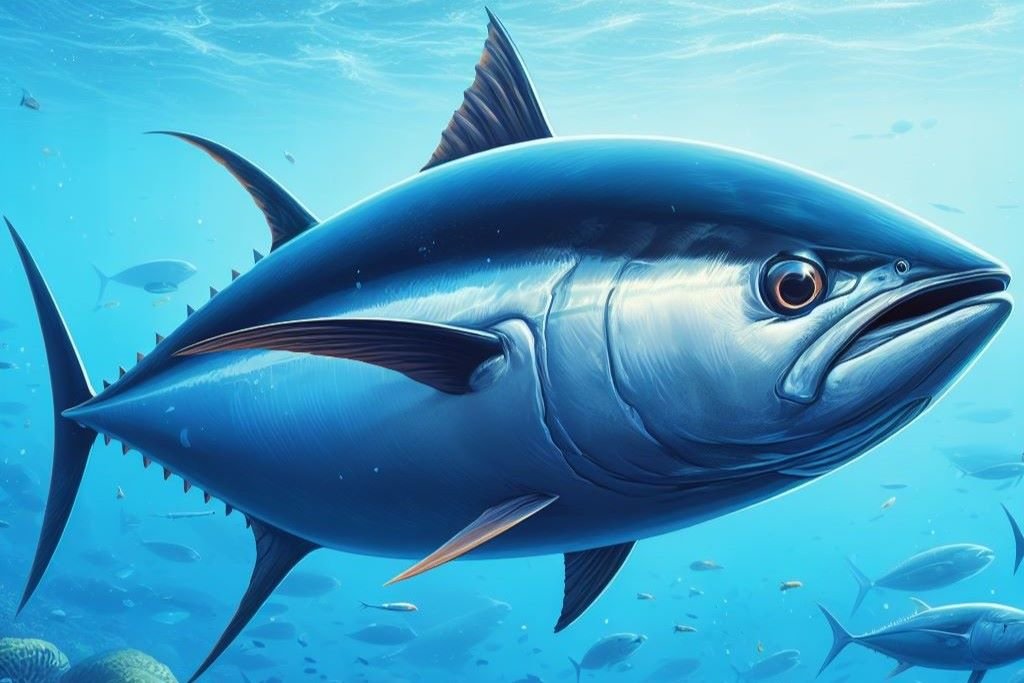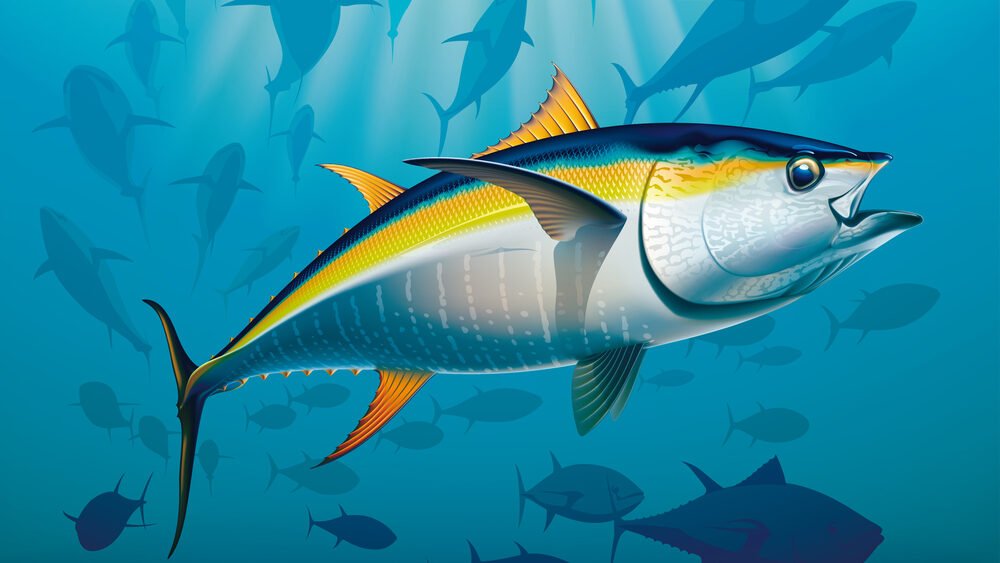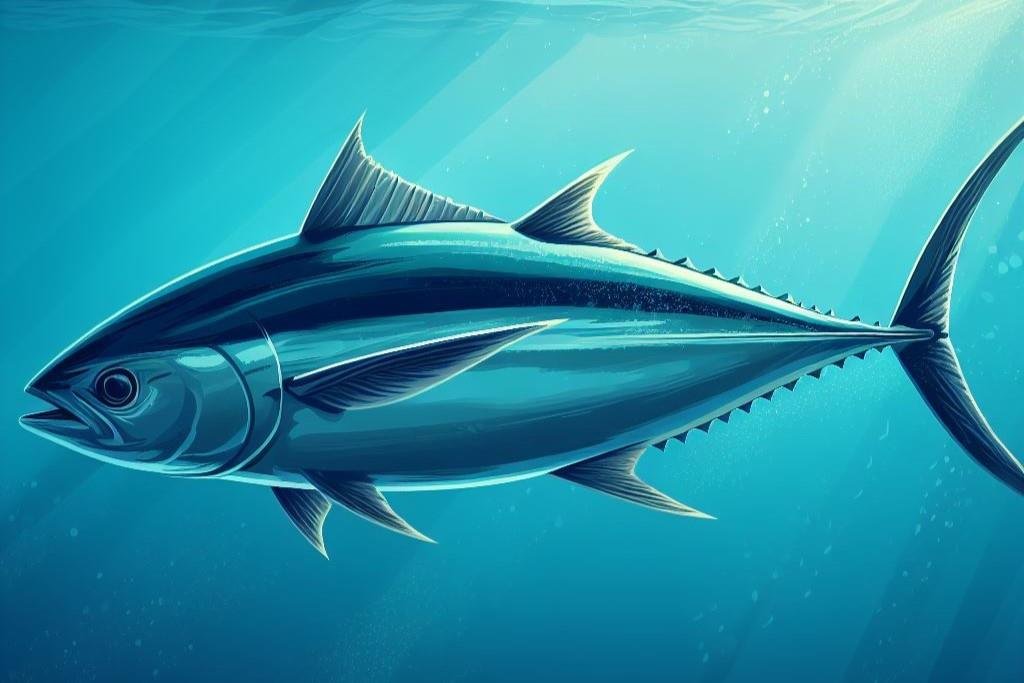Exploring the Diverse Tuna Species of the World
Tuna are large, predatory fish that belong to the tribe Thunnini under the mackerel family Scombridae. Found in warm seas across the globe, tuna exhibit incredible speed, endurance and migrations across vast expanses of ocean.
There are over 15 recognized species of tuna that inhabit our waters, each possessing their own distinguishing traits and behaviors. In this article, we will explore some of the most prominent tuna species, examining their key characteristics and role within their marine ecosystems.
5 Amazing Tuna Fish Fun Facts
Here are 5 amazing and surprising fun facts about tuna species:
- Warm-Blooded Bluefin Tuna: Bluefin tunas are warm-blooded, which is a rare trait among fish. This unique adaptation allows them to maintain a higher body temperature than the surrounding water, which enhances their swimming performance and endurance.
- Diverse Diet: Tuna have a diverse diet, ranging from migratory fish and squid for smaller species to marine mammals, octopus, and larger fish for giant tunas. Their powerful jaws and keen sense of smell enable them to efficiently hunt and consume a wide variety of prey.
- Migratory Habits: Thanks to substantial research, there is a deeper understanding of the migratory habits of bluefin tuna. This knowledge has enabled the development of strategies to protect the species, highlighting the fascinating migratory behavior of these fish.
- Role in Ecosystem: Tuna play a crucial role in marine ecosystems as apex predators, helping to maintain ecological balance by regulating certain marine life. Additionally, their activities contribute to mixing water layers, storing carbon, and cycling nutrients that fuel the entire ocean food chain.
- Size Variation: Tunas come in various sizes, with the Atlantic bluefin tuna being one of the largest, averaging 2 meters in length and believed to live up to 50 years. On the other end of the spectrum, the bullet tuna reaches a maximum length of 50 cm and a weight of 1.8 kg.
These fun facts shed light on the remarkable characteristics and ecological significance of tuna species.
Tuna Species Quick Overview
| Attribute | Information |
|---|---|
| Scientific name | Thunnus spp. |
| Kingdom | Animalia |
| Phylum | Chordata |
| Class | Actinopterygii |
| Order | Scombriformes |
| Family | Scombridae |
| Genus | Thunnus |
| Species | Albacore (Thunnus alalunga), Southern bluefin tuna (Thunnus maccoyii), Bigeye tuna (Thunnus obesus), Pacific bluefin tuna (Thunnus orientalis), Blackfin tuna (Thunnus atlanticus), Yellowfin tuna (Thunnus albacares), Northern bluefin tuna (Thunnus thynnus), Longtail tuna (Thunnus tonggol) |
| Common names | Albacore, Southern bluefin tuna, Bigeye tuna, Pacific bluefin tuna, Blackfin tuna, Yellowfin tuna, Northern bluefin tuna, Longtail tuna |
| Description | Tuna are saltwater fish that belong to the tribe Thunnini, a subgrouping of the Scombridae (mackerel) family. They are fast swimmers and have a streamlined body shape that allows them to swim quickly through the water. |
| Appearance | Tuna have a torpedo-shaped body, a pointed head, and a forked tail. They are typically dark blue or black on the back and upper sides, with a silver or white underside. |
| Size | Tuna vary greatly in size, ranging from the bullet tuna (max length: 50 cm or 1.6 ft, weight: 1.8 kg or 4 lb) up to the Atlantic bluefin tuna (max length: 4.6 m or 15 ft, weight: 684 kg or 1,508 lb), which averages 2 m (6.6 ft) and is believed to live up to 50 years. |
| Habitat | Tuna are found in the open ocean, usually in warm waters. They are highly migratory and can travel long distances in search of food. |
| Distribution | Tuna are found in oceans around the world, with some species being more common in certain regions. |
| Diet | Tuna are carnivorous and feed on a variety of prey, including fish, squid, and crustaceans. |
| Reproduction | Tuna are oviparous, meaning they lay eggs. Fertilization is external, and the eggs hatch into larvae that drift with the ocean currents. |
| Lifespan | Tuna can live for several decades, with some species living up to 50 years. |
| Ecological role | Tuna play an important role in marine ecosystems as top predators. They help to regulate the populations of their prey species and are themselves preyed upon by larger predators such as sharks and killer whales. |
| Predators | Tuna are preyed upon by larger predators such as sharks and killer whales. |
| Conservation status | Several species of tuna are considered to be threatened or endangered due to overfishing and habitat loss. |
| Economic importance | Tuna are an important commercial fishery, with many species being highly valued for their meat. They are also popular game fish and are sought after by recreational fishermen. |
| Human interaction | Tuna are caught by commercial and recreational fishermen using a variety of methods, including longline fishing, purse seining, and trolling. They are also farmed in some parts of the world. |
| Evolution | Tuna are thought to have evolved around 50 million years ago, during the Eocene epoch. |
| Adaptations | Tuna have several adaptations that allow them to swim quickly through the water, including a streamlined body shape, a powerful tail, and a system of countercurrent exchange that helps to maintain their body temperature. |
| Research & discoveries | Scientists continue to study the biology and ecology of tuna, as well as the impacts of fishing and other human activities on their populations. |
| Captivity & aquarium trade | Tuna are not commonly kept in captivity due to their large size and migratory behavior. However, some aquariums have been successful in keeping and displaying smaller species of tuna. |
Atlantic Bluefin Tuna – Largest and Most Imperiled of the Tunas

The Atlantic bluefin tuna (Thunnus thynnus) is the giant of the tuna family, capable of reaching lengths over 13 feet and weights exceeding 2,000 pounds. It is one species of the bluefin tuna genus, Thunnus. Their torpedo-shaped bodies are stout and robust, with a dark blue-black back that fades to silver-white on the underside. Rows of pale horizontal stripes run the length of their body. The Atlantic bluefin possesses a large, sickle-shaped dorsal fin and relatively short pectoral fins situated low on the body. These fish are unique in having a circulatory system that helps retain metabolic heat, enabling them to thrive in colder northern waters.
Atlantic bluefins inhabit both sides of the Atlantic between the latitudes of Norway to Brazil in the west, and South Africa to Oceania in the east. Highly migratory, they will range thousands of miles searching for food and mates. Bluefins are apex predators that hunt schooling fish like herring, mackerel and squid. They have even been observed attacking sea turtles! Reaching sexual maturity around 8 years, spawning occurs between April-June. The fertilized eggs hatch in 48 hours.
Unfortunately, decades of overfishing has led to a catastrophic decline in Atlantic bluefin populations. Strict quotas must be enforced to prevent this magnificent fish from being lost forever.
Yellowfin Tuna – Tropical Speedster of Warm Seas

The yellowfin tuna (Thunnus albacares) lives up to its name with the yellow hue of its scales and fins. Reaching lengths over 6 feet, their torpedo-shaped bodies allow them to cruise at rapid speeds chasing down prey. Metallic dark blue covers the back and sides, fading to silvery white on the underside. Long, sweeping dorsal and anal fins run nearly the entire length of their bodies, with oversized sickle-shaped pectoral fins used for maneuverability.
Found in tropical and subtropical waters worldwide, yellowfin tuna prefer surface temperatures above 18°C. Highly migratory, they range across all the major oceans basins. Yellowfin tuna are opportunistic feeders that hunt squid, crustaceans and a wide variety of small fish species. Schools of yellowfin will even associate with dolphins, using the marine mammals to locate food. Fast growing and short lived, yellowfin rarely exceed 6 years in age. Spawning takes place year-round in equatorial regions, peaking during the warmer months.
Albacore Tuna – Temperate Wanderer of the Open Ocean

With a streamlined, torpedo-shaped body, the albacore tuna (Thunnus alalunga) is built for speed and endurance. Dark blue covers the back and head, transitioning to silvery sides and belly. Long pectoral fins provide lift and maneuverability. Albacore tuna differ from other species by having a second dorsal fin nearly as long as the first. Reaching lengths over 4 feet, albacore are moderately sized tuna.
Albacore tuna range across temperate and tropical waters in the Atlantic, Pacific and Indian Oceans. Highly migratory, they travel great distances searching for food. Unlike other tuna, albacore do not school with different species and tend to form single-species feeding aggregations. Prey items include fish, crustaceans and squid. Albacore tuna are an important commercial species, forming the majority of “light tuna” canned products. They have a lifespan of around 12 years.
Bigeye Tuna- Deep Diving Denizen of the Tropics

Similar in length to the yellowfin but with a stouter body, the bigeye tuna (Thunnus obesus) gets its common name from having larger eyes than its relatives. Metallic blue-black covers the back and sides, transitioning to silvery-white on the underside. Long sweeping dorsal and anal fins are a yellow hue, as are the finlets bordered in black. Bigeye tuna possess exceptional visual acuity that aids in spotting prey at depth.
Found worldwide in tropical and subtropical seas, bigeye tuna tolerate a wide thermal range between 10-30°C. They primarily inhabit deep offshore waters, undertaking vertical migrations from the surface to depths over 500 feet. This allows them to hunt deep-dwelling prey items unavailable to other tuna. Squid, fish and crustaceans are consumed. Bigeye tuna occasionally form multi-species aggregations when food is abundant. Lifespans reach 16 years.
Skipjack Tuna – High-Energy Roamer of Warm Seas

The smallest of the major commercial tunas, the skipjack tuna (Katsuwonus pelamis) reaches lengths of around 3 feet. Their torpedo-shaped bodies are an iridescent dark blue on top and silver-white on the bottom. Several dark bands run horizontally along their sides. Highly active and fast swimming, skipjacks constantly cruise the upper layers of the ocean in search of food.
Skipjack tuna inhabit tropical and subtropical waters between 45°N and 45°S latitude. They undertake remarkable transoceanic migrations in massive schools that may intermingle with other tuna species and marine animals. Opportunistic feeders, they consume a variety of baitfish, crustaceans and squid. Highly productive, skipjacks spawn multiple times a year across their broad range. They rarely live longer than 8 years.
Key Tuna Traits and Adaptations
Several key anatomical and physiological traits allow tunas to thrive as powerful ocean predators:
- Torpedo-shaped bodies – The tunas’ compact, streamlined bodies minimize drag and allow them to cruise at high speeds and undertake lengthy migrations.
- Thunniform swimming – Their specialized tails move from side-to-side, providing continuous propulsion. This swimming style allows tunas to continuously swim without rest.
- Powerful muscles – Tunas possess a high concentration of red aerobic muscle tissue and blood capillaries that provide sustained swimming strength.
- Specialized circulatory system – A counter-current blood flow allows tunas to maintain elevated body temperatures. This enables them to thrive in colder waters where prey is more abundant.
- Keen vision – Many tuna species have specialized eyes that detect subtle movements and light fluctuations. This aids in identifying prey items.
Tunas as Top Oceanic Predators
Tunas belong to an elite group of highly-mobile, powerful hunters that sit atop complex marine food chains. Several key attributes contribute to their role as apex oceanic predators:
- Speed – Tunas are among the fastest swimming species, capable of short bursts over 40 mph. This allows them to readily chase down swift prey.
- Powerful jaws – Strong biting force and sharp teeth make short work of large prey like fish and squid.
- Efficient metabolism – Tunas have high rates of digestion, enabling them to eat up to 10% of their body weight daily. Large amounts of forage fish, squid and crustaceans are consumed.
- Keen senses – Their vision, sense of smell, motion detection and pressure sensitivity all help tunas efficiently locate prey across vast distances.
- Heated bodies – Elevated body temperature improves muscle power output, reaction time, circulation and digestion – all providing a competitive edge.
Due to their voracious appetites and transoceanic ranges, tunas exert a top-down influence on marine food webs. Their migrations connect distant ecosystems, transporting nutrients between regions. However, overfishing is disrupting tuna populations, which has cascading effects across entire marine ecosystems. Sustainable management practices are crucial for preserving tunas and the health of our oceans.
Threats Facing Global Tuna Populations
Many tuna species have experienced concerning population declines over the past 50 years due to a combination of factors:
- Overfishing – Global fishing fleets have dramatically increased their tuna catches since the 1950s to supply growing demand for canned tuna and sushi. Total catches have quadrupled in this period.
- Bycatch – Tuna fishing frequently catches other species like sharks, billfish and seabirds as unintended bycatch. This threatens already declining populations.
- Habitat degradation – Pollution, coastal development, climate change and other human impacts degrade tuna habitats, reducing survival rates.
- Management limitations – Difficulty coordinating sustainable tuna management across geopolitical boundaries has hampered conservation efforts. Illegal and unregulated tuna fishing also continues.
Protecting tuna biodiversity is crucial for healthy oceans. Strict catch limits, fishing gear changes to reduce bycatch, new time/area closures, and increased cooperation between fishing nations offer hope for preserving these amazing ocean predators.
FAQs About Tuna Species
What’s the biggest species of tuna?
The Atlantic bluefin is the largest tuna and can reach lengths over 13 feet and weights over 2,000 pounds.
Which species has the highest commercial value?
Atlantic and Pacific bluefin tuna are the most valuable species, with individual fish selling for over $1 million at auction in Japan. Their fatty meat is prized for sashimi.
How fast can tunas swim?
Tunas are capable of rapid bursts of speed over 40 mph for short durations. Skipjack tuna have been recorded exceeding speeds of 47 mph.
Do tuna species migrate?
Yes, most tuna species undertake extensive migrations across ocean basins in search of food and spawning areas. Some migrations can exceed 5,000 miles.
What is the lifespan of a typical tuna?
Depending on species, tunas generally live 10-15 years. Some Atlantic bluefin can live over 25 years.
Which oceans can tunas be found in?
Different tuna species inhabit tropical, subtropical and temperate waters in the Atlantic, Pacific and Indian Oceans. Their range spans from roughly 45°N to 45°S latitude.
Do tunas school with other fish species?
Some tuna species will form mixed-species schools, particularly skipjacks schooling with yellowfins. Tunas also associate with dolphins, whales and other marine animals.
How are tunas able to keep warm in colder waters?
Tunas possess a specialized circulatory system that retains metabolic heat, enabling them to maintain body temperatures above ambient conditions.
Why are tuna populations declining?
Decades of overfishing, bycatch, habitat degradation and inadequate international management have caused concerning declines among many tuna species.
In summary, tunas display remarkable ecological and physiological adaptations that enable them to thrive as powerful ocean predators. However, unsustainable fishing practices and environmental changes now threaten the future of these iconic fish. More work remains to secure the long-term viability of tuna populations worldwide.

